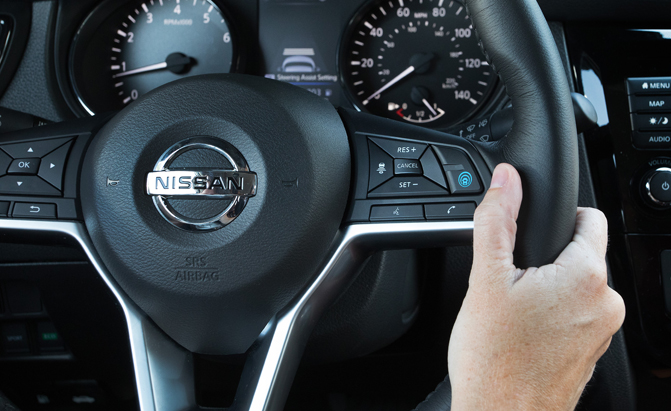Self-driving cars might be a sci-fi staple but with the new Nissan Leaf, the automaker’s ProPILOT Assist technology is making the idea much more realistic.
The release of the latest Star Wars film, The Last Jedi, provided an opportunity for Nissan to shine a light on its new technology. Nissan’s partnership with Star Wars goes beyond just marketing and enabled us to use ProPilot assist to drive to the premiere of the new movie in L.A.
What is ProPILOT Assist?
ProPILOT Assist is an advanced adaptive cruise control system that reduces the stress of driving by letting the vehicle handle acceleration and braking duties over an extended time under certain driving conditions and is mainly meant for single-lane highway driving. Control of the steering is a dual effort by both the driver and the car, as your hands are expected to be at the wheel at least 95 percent of the time while using ProPILOT.
ALSO SEE: Here’s Why the Star Wars and Nissan Partnership Works So Well
The ProPILOT system is currently available in the top trim Platinum version of the Nissan Rogue and will be available in the SV and SL trim levels for the upcoming Leaf.
The 2018 Nissan Leaf is the company’s foundation for the development of a fully autonomous vehicle in the future. The Japanese automaker is using this vehicle as a real-world test bed for what consumers like about autonomous tech as well as things they may not be so keen on.
ProPILOT Assist is Smartly Calibrated
In between lightsaber training (yes, you read that right) and looking for hidden Star Wars BB-8 collectibles around Los Angeles, Nissan sent us on a scavenger hunt with ProPILOT-equipped Rogues and Leafs that took us to places scattered across town — the grueling stop-and-go traffic that L.A. is famous for was the perfect testing grounds for Nissan’s tech.

Activating the ProPILOT system is very simple. A clearly marked blue button on the steering wheel is first pressed to activate the system and then the “set” button is pressed, just like if you were using regular cruise control. The vehicle soon begins to gently steer and follow vehicles ahead of you at the set chosen speed and distance. ProPILOT is also integrated with the intelligent cruise control system and can both brake and accelerate for you, continuously adjusting depending on the car’s distance from the vehicle ahead. It will stop and get going again all on its own. It’s an eerie sensation at first, but you quickly learn to trust the system.
ALSO SEE: 2018 Nissan Leaf Review
ProPILOT uses a windshield-mounted camera and a front-facing radar sensor to read lane markers and keep the car in the middle of its lane at all times.
According to Brittany Tessmer, a senior engineer behind the ProPILOT system, this technology is designed to assist during the daily commute. “ProPILOT Assist’s main intention is to reduce your driving workload and not drive the car for you,” she said. “You work together with the car to take control of the vehicle but both you and the vehicle still rely on each other to do their part when necessary.”
ProPILOT’s major selling point is just how eerily similar it operates compared to a human driver. The Rogue or Leaf never applied the brakes too suddenly or artificially. Acceleration was also well modulated and never too aggressive. Some adaptive cruise control systems leave too much room between you and the car in front, making it too easy for other cars to cut you off, then compensate by slamming on the brakes. Nissan’s system is always adjusting smoothly and leaving just enough space, just like what a human driver would do in such traffic conditions.

Limitations
ProPILOT’s major concern is to keep you in your lane at all times. It has to be able to read lane markers clearly and heavy sunlight can diminish the system’s ability to function well. Bad weather will also hamper ProPILOT’s ability to do its job.
Also, the system is most effective during freeway driving and it isn’t recommended for use in the city. The system’s requirement to always see lane markers on both the right and left side makes it hard for it to function properly on city streets with just one middle lane marker and on streets where lanes are not marked consistently.
The ProPILOT system lets you take your hands off the wheel for approximately three to five seconds. The moment you break that first rule, the Leaf sends a visual warning to take back control of the wheel. Any further attempts to push your luck will result in audible beeps and eventually, if there is still no response from the driver, this will prompt the car to come to a stop and turn on the emergency hazard lights.
ProPILOT would be better if the time drivers are allowed to take their hands off the wheel was a bit longer. Three to five seconds is too quick for the system to start giving such aggressive warnings.
ALSO SEE: 8 Things You Need to Know About the 2018 Nissan Leaf
Nissan says this current iteration of the technology is just a first phase and plans are in motion to expand its capabilities to lane changing and other complex driving functions. As a first stage, ProPILOT is impressive and really helps bring some sci-fi ideas into the real world.



Leave a Reply